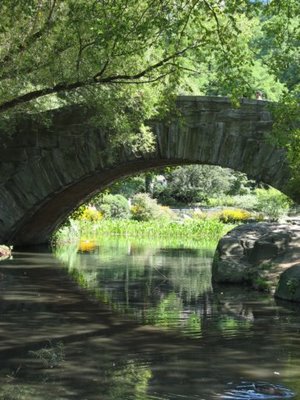I'm torn.
Perhaps my two greatest interests, outside of Star Trek and politics, are history and the environment.
But there is a controversy simmering right here just a few miles away that puts those two interests at odds.
I'm talking about Valley Forge National Park and the proposal to build a hotel, conference center
and two-story, 130,000 square-foot museum of the American Revolution on a 78-acre parcel in parcel in Lower Providence which is bordered on 96 percent of its property line by federal park land.
My problem is this: I love museums, particularly history museums and particularly history museums that deal with our nation's founding, a period of time I find truly remarkable in regards to the thought and accomplishments of mankind. I view that period, the end of the Enlightenment, as what might be called a "paradigm shift" in how we view ourselves and our rights and responsibilities to ourselves.
So being a regional partisan, I would absolutely argue that a national museum dedicated to the American Revolution belongs here, outside Philadelphia (instead of say, Boston) where so many of those vital issues we still debate today, were first debated as a nation.
Locating it at Valley Forge is not only appropriate because it is the place where George Washington gave up on his losing strategy of trying to win a war against the largest army in the world, and adopted the more practical strategy, ultimately successful, of not losing the war.
Further it would make the region more of a tourist draw and some of those tourists might be drawn to Pottstown to spend money.
But there's a problem.
The museum is not being built on public park land or by the National Park Service, as I might prefer, but by a private developer.
Understand, I do not believe that everything is best done by government. My visit last year to Mount Vernon was splendid and made more so when I discovered the improvements to that site accomplished in the last 10 years, were done largely through grants to a non-profit foundation that owns and runs the landmark home of our first and best national hero.
But the folks who want to build this museum (and hotel) are trying to make money. Again, all very American but something which thus infuses a degree of skepticism to the entire enterprise, seeing as they will be trading on a public resource to make private profit.
They will argue, no doubt, that their facility will enhance that resource and that may well be true. But private companies are not accountable to the American people and thus we have only their word.
After all, I have been to some bad museums in my lifetime.
But the true conflict is epitomized by the testimony of a park official at a recent zoning hearing board meeting as reported in
this article by Carl Rotenberg from our sister newspaper,
The Times-Herald in Norristown and posted on
The Green Pages of
The Mercury's Web site.
Deirdre Gibson, the chief of planning and resource management at the park, told the zoning board that the development "will hurt the adjacent Valley Forge National Historical Park's wildlife habitat, viewsheds, drainage and archaeological artifacts," Rotenberg reported.
Those are hard impacts to accept to benefit a for-profit project.
Certainly, the Valley Creek which runs through the park can absorb any more polluted run-off into its already stressed waters.
Beyond the damage and impacts to the natural features, no small matter, no true lover of history can condone the destruction of archaeological artifacts with the potential to increase our understanding of the very history such a museum would seek to interpret.
Thus, my dilemma.
I would like nothing more than to be able to pop down Route 422, or, preferably, ride my bike down on the Schuylkill River Trail, to visit the American Revolutionary Museum several times a year.
But how can a die-hard environmentalist condemn the destruction of open space and watersheds to make room for the construction of office parks or subdivisions, but suddenly endorse the same when what is being built appeals to his or her sensibilities?
For as Joni Mitchell once so insightfully sang (yes, I'm showing my age here), "don't it always seem to go, that you don't know what you've got till its gone?"
I am a fan of history, but not of the hypocrisy so often found within its pages. And now I must turn that spotlight on myself and ask what I truly believe.
One thing I do believe is that if this project is fought off, the chances of another, more acceptable proposal to build an American Revolution museum at Valley Forge will dwindle to nearly nothing.
As I wrestle with this personal dilemma, this might be the place to note that this conflict of interests is not unique to Valley Forge Park.
As t
his article in The Christian Science Monitor indicates, up to 1.8 million acres of privately held lands adjacent to National Parks all over the country are under development pressure, developments that may well ruin or degrade the very asset on which they are meant to capitalize.
That figure comes from a recent study by the National Parks Conservation Association, a non-profit advocacy group which is also, not coincidentally, suing to over-turn as "spot zoning" the Lower Providence overlay zoning that would allow the construction of the complex at Valley Forge.
Currently, there is a back-log of parcels the park service had intended to buy but can now no longer afford due to budget cuts.
"Park Service land-acquisition budgets were cut from $147 million in 1999 to just $44 million this year, a 70 percent drop. Most parks have had little funding for land acquisition for years. Yet there’s a limit to how long even public-spirited land-owners are willing to wait," the Monitor reported.
“Time is a real factor here,” says Greg Caffey, chief ranger at Petrified Forest National Park, gesturing over the park fence to a large excavator that has been digging up petrified wood on private land next to the park, the Monitor reported.
The years of delay have now left important parks at acute risk, NPCA officials say. Inside Gettysburg National Military park, for instance, one-in-five acres is privately owned and could be commercialized.
Just two years ago, developers proposed building a slots parlor less than two miles from the battlefield where, as Lincoln so poetically described, thousands of Americans "gave their last full measure of devotion."
In March, the NPCA gave the leader of the grassroots organization, No Casino Gettysburg, its
annual Marjory Stoneman Douglass Award in recognition of the successful effort to stop it.
In the Monitor article, Ron Tipton, senior vice president for programs at NPCA used the Valley Forge fight as an example of the larger problem.
“You’re leaving America’s heritage at risk,” said Tipton. “Private owners have a legal right to get value for their property. If the Park Service can’t do that in a timely way … we’re going to have situations like Valley Forge and Petrified Forest. When you only give the Park Service $30 [million] to $40 million, you can’t do it.”
In 1965, Congress created the Land Water and Conservation Fund to purchase land for federal agencies, partly with the goal of eliminating potential development conflict with natural park surroundings.
"But under the Bush administration, budget requests for land acquisition funds for national parks fell from $172 million in 2000 to $21.8 million for this next fiscal year.
A Republican-led Congress had been cutting Park Service land acquisition budgets even faster than the administration – until Democrats took control in 2006 and restored some funding. This year, Congress appropriated $44 million, double the administration request," the Monitor reported.
And of course, not all that money goes into land purchases. This year's budget was $22 million, but more than $8 million went to pay the costs of administering that fund.
Further, the Bush administration spends much of the fund on programs that don't purchase land at all, according to a 2006 study by the Congressional Research Service.
Rather two thirds of a fund that had shrunk from $969 million to $346 million in five years went not to purchase land but to "other programs."
These include the push by the administration for cooperative programs that pay private land owners to maintain resources on their land to support rare or endangered species living there, also a laudable goal and quite probably, at least in concept, a cost-effective one.
“The administration’s position is strong that we have to take care of the land we have now,” Jeffrey Olason, a spokesman for the park service, told the Monitor. “Budgets are tight and a war is going on.”
Certainly, this is not to be denied.
And right now, there's a war raging in my heart as well. As yet, no clear victor has emerged.

 RSS
RSS


